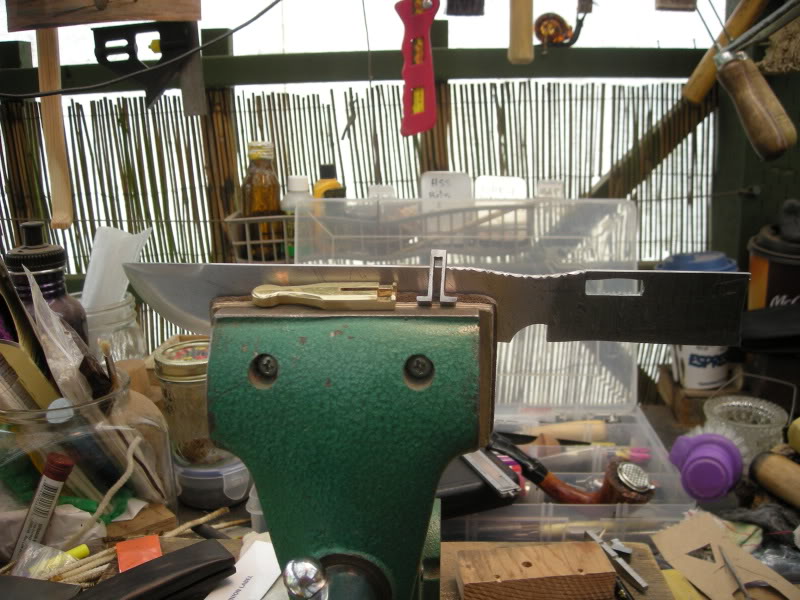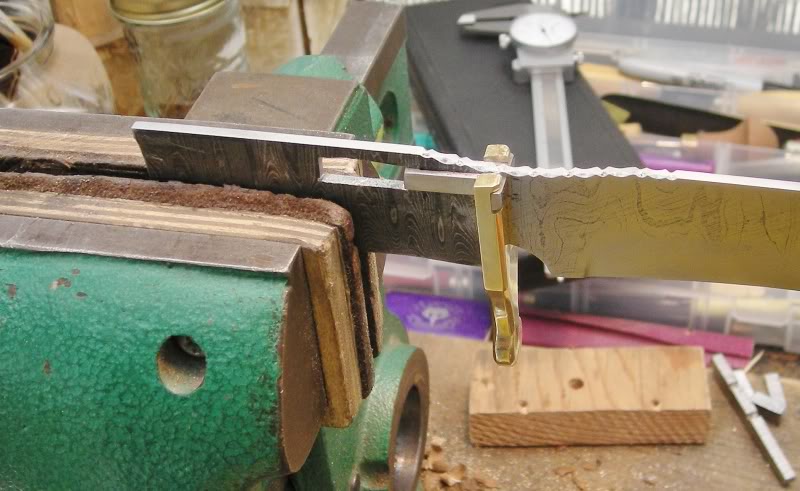This is one of the Damascus projects I'm working on currently. It started as a nice billet of Damascus steel, a block of Gabon Ebony and some heavy brass sheetstock. Then it got kind of fun.
I ran into a situation in which I wanted to attach the brass guard to the steel blank and didn't want to drill it from the side in order to pin it properly. And then I didn't have the right size rod stock to make the pans anyway. So...um... This is actually quite funny in a sad twisted way, right? So anyway, I got to thinking about what else I could do to secure it effectively...and I noticed the heavy sheet of brass I had cut the guard from...and there was this groove milled out across the top, and it got me thinking, which is always a dangerous circumstance. Well, one thing led to another and (being a very 'visual' person in terms of how I approach most things) the solution just sort of popped into being...you know...like the Venus...sprung fully formed from the head of Zeus? Yes, well, enough of that. So I re-cut the guard in a slightly different design and started rummaging around in my scrap drawer for some steel (did I mention that this is all done by hand...hack, coping and jeweler's saws...needle and riffling files and the like) none of those fancy machines that would make the work...you know...SANE!
Anyway...the pics below should sort of show what I ended up doing to prevent making one frigging drill hole and stuffing a pin into it.
Oh...and if you're wondering about the handle, and why what likely should have been a full tang design has the tang extending only halfway down the hangle...well there's a story behind that too. <<snicker>> I had a piece of damascus just so long, and I wanted a blade of 6" and a handle of about 5" (to fit my mitt)...but I had plenty of Ebony. So I cut a channel into the Ebony...which is only like twenty times more difficult than cutting the piece into two slabs and all, and of course there's that 'by hand' thing in there again.
I included a pic of the knife in profile...please understand that the butt will have a brass cap the same thickness as the guard...holefully attached my traditional means...but ya just never know...
The parts...prior to assembly:

And assembled:

And roughly what it will look like - though it's finish will be improved of course, and the brass buttcap, etc.:

I ran into a situation in which I wanted to attach the brass guard to the steel blank and didn't want to drill it from the side in order to pin it properly. And then I didn't have the right size rod stock to make the pans anyway. So...um... This is actually quite funny in a sad twisted way, right? So anyway, I got to thinking about what else I could do to secure it effectively...and I noticed the heavy sheet of brass I had cut the guard from...and there was this groove milled out across the top, and it got me thinking, which is always a dangerous circumstance. Well, one thing led to another and (being a very 'visual' person in terms of how I approach most things) the solution just sort of popped into being...you know...like the Venus...sprung fully formed from the head of Zeus? Yes, well, enough of that. So I re-cut the guard in a slightly different design and started rummaging around in my scrap drawer for some steel (did I mention that this is all done by hand...hack, coping and jeweler's saws...needle and riffling files and the like) none of those fancy machines that would make the work...you know...SANE!
Anyway...the pics below should sort of show what I ended up doing to prevent making one frigging drill hole and stuffing a pin into it.
Oh...and if you're wondering about the handle, and why what likely should have been a full tang design has the tang extending only halfway down the hangle...well there's a story behind that too. <<snicker>> I had a piece of damascus just so long, and I wanted a blade of 6" and a handle of about 5" (to fit my mitt)...but I had plenty of Ebony. So I cut a channel into the Ebony...which is only like twenty times more difficult than cutting the piece into two slabs and all, and of course there's that 'by hand' thing in there again.
I included a pic of the knife in profile...please understand that the butt will have a brass cap the same thickness as the guard...holefully attached my traditional means...but ya just never know...
The parts...prior to assembly:

And assembled:

And roughly what it will look like - though it's finish will be improved of course, and the brass buttcap, etc.:

